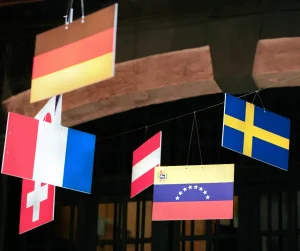When you honour their perspectives, you'll earn their trust and repeat business.
You’ve worked hard to build your business, but connecting with non-English speaking background clients poses unique communication challenges.
Don’t let language barriers derail your customer relationships. With some preparation and effort, you can bridge divides and forge strong bonds with CALD clients.
In fact, a 2018 study published in the Journal of Intercultural Communication found that 93% of diverse clients felt more loyal to businesses that made an effort to communicate in their native languages.
So take steps to understand your clients’ cultures and communication preferences. Show them you care by making small adjustments to your services, marketing, and operations. When you honour their perspectives, you’ll earn their trust and repeat business.
Understanding the Needs of Your NESB Clients
Breaking Down Language Barriers
Strong communication is the cornerstone of thriving business partnerships. For non-English speaking background clients, language can present a significant barrier. A 2019 study by the Australian Bureau of Statistics found that over 21% of Australians speak a language other than English at home.
To bridge this gap, it’s crucial to go beyond simply translating words. Cultural nuances, idioms, and nonverbal cues can easily get lost in translation. Seek out professional interpreters and translators who deeply understand both languages and cultural contexts.
Non-English speakers access information from various sources. While some may require telephone interpreter service, others are comfortable with digital communication platforms. It’s essential to accommodate these different preferences to effectively reach out to your non-English speaking background clients or CALD clients.
Considering Literacy Levels
Even within shared languages, literacy levels can vary greatly. A 2018 report by the Australian Council for Educational Research highlighted that nearly 44% of Australians have literacy skills below the minimum required for everyday life and work. This was strengthened by a report by the Australian Bureau of Statistics that revealed that nearly 15% of Australians aged 15-74 have lower literacy skills, which can hinder their ability to comprehend written materials.
Adapting your communication strategies to address varying literacy levels is essential. When communicating with NESB clients, avoid overly complex terminology or jargon. Use clear, concise language and provide visual aids or multimedia resources where possible. This inclusive approach ensures your message resonates with clients across all literacy levels.
Embracing Cultural Sensitivity
Language is deeply intertwined with culture. Effective communication with NESB clients hinges on developing cultural competence within your organisation. To truly connect with your NESB clients, you must embrace cultural sensitivity. This means understanding and respecting their values, traditions, and communication styles.
For example, in some cultures, direct eye contact may be seen as disrespectful, while in others, it’s a sign of attentiveness.
Research by the University of Sydney highlights the importance of cultural competence in building trust and rapport with clients from diverse backgrounds.
By demonstrating a genuine interest in their cultures and tailoring your approach accordingly, you can foster stronger connections and enhance client satisfaction.
Going the Extra Mile
Building strong relationships with NESB clients often requires going above and beyond. Consider offering multilingual resources, such as translated brochures, websites, or even audio/video content in their native languages.
Additionally, provide clear communication channels, such as dedicated phone lines or email addresses staffed by multilingual representatives. This level of accessibility and personalised service can set your business apart and foster long-lasting client relationships.
By understanding and catering to the unique needs of your NESB clients, you’ll not only improve communication but also demonstrate a genuine commitment to inclusivity and cultural awareness – values that resonate deeply in Australia’s diverse society.
Crafting a Communication Strategy for Success
Effective communication is vital when working with non-English speaking backgrounds clients (NESB). By crafting a well-thought-out strategy, you can overcome language barriers and build strong relationships rooted in trust and understanding.
Assess Your Client’s Needs
Before anything else, take the time to assess your NESB client’s specific communication needs. Do they require an interpreter? What is their level of English proficiency? Understanding their unique situation allows you to tailor your approach accordingly.
Embrace Visual Communication
When dealing with language differences, visuals can be incredibly powerful tools. Incorporate diagrams, charts, and images into your discussions to clarify complex concepts and ensure everyone is on the same page. According to a study by the University of Minnesota, visuals improve comprehension by up to 89%.
Keep It Simple
Speak slowly, use plain language, and avoid jargon or idioms that may confuse NESB clients.
Break down information into manageable chunks, and frequently check for understanding. As Dr. Mara Rowles of the University of Sydney emphasises, “Simple language doesn’t mean simplistic – it means clear and accessible.”
The power of plain language cannot be overstated when working with clients who have limited English proficiency. Use straightforward vocabulary, short sentences, and avoid complex idioms or jargon. This approach ensures your message is easily understood and reduces the risk of miscommunication.
Leverage Technology
In today’s digital age, numerous tools can facilitate cross-cultural communication. Consider using translation apps, video conferencing with live captions, or even multilingual chatbots to streamline interactions and ensure accurate information exchange.
Build Cultural Awareness
Familiarise yourself with your NESB client’s cultural norms and values. This awareness can help you navigate potential misunderstandings and build rapport more effectively. As the Australian Institute of Interpreters and Translators notes, “Cultural competence is key to successful cross-cultural communication.”
Promote Inclusivity
Make NESB clients feel welcomed and valued by actively involving them in discussions and decision-making processes. Encourage them to ask questions, voice concerns, and provide feedback. An inclusive environment fosters trust and collaboration.
Foster a Culture of Patience and Respect
 Effective communication requires patience and respect on both sides. Encourage active listening, ask clarifying questions, and provide ample time for clients to process information and respond. Avoid rushing or appearing impatient, as this can create an unwelcoming environment and hinder open communication.
Effective communication requires patience and respect on both sides. Encourage active listening, ask clarifying questions, and provide ample time for clients to process information and respond. Avoid rushing or appearing impatient, as this can create an unwelcoming environment and hinder open communication.
Seek Professional Support
When complex or sensitive matters arise, consider enlisting the services of professional interpreters or translators. These experts can ensure accurate communication, prevent misunderstandings, and help you navigate cultural nuances with ease.
By implementing these strategies, you can effectively communicate with NESB clients, build strong relationships, and ultimately drive business success. Remember, clear communication is the foundation of any successful partnership.
Building Trust Through Effective Communication
Establishing trust is crucial when communicating with non-English speaking backgrounds clients. Without a solid foundation of trust, even the most well-intentioned efforts can fall flat. To truly connect and serve these clients effectively, businesses must prioritise clear, empathetic communication.
The Art of Truly Hearing Your Clients
Active listening is the bedrock of building trust. Clients who feel listened to and validated are more likely to be forthcoming and participate actively. Simple techniques like maintaining eye contact, nodding, and paraphrasing can go a long way in making NESB clients feel valued.
Summarise what you’ve heard to ensure clarity. Ask thoughtful follow-up questions to gather more context.
A 2019 study by the University of Melbourne found that clients who felt their service provider actively listened were 67% more likely to continue the business relationship long-term. Demonstrating patience, avoiding interruptions, and allowing silence can create a safe space for NESB clients to express themselves fully.
Images and Icons That Speak Volumes
While verbal communication is key, visuals should not be overlooked. Incorporating culturally relevant images, icons, and symbols into your materials can help bridge linguistic gaps.
A 2021 report by Deakin University revealed that 83% of Non-english speaking background clients better understood service offerings when visuals were used effectively.
Infographics, diagrams, and pictorial representations can convey complex information accessibly. However, be mindful of cultural sensitivities and avoid visuals that could be misinterpreted or offensive to certain groups.
Utilising Technology to Bridge The Gap
In our digital age, businesses have a wealth of tools at their disposal to enhance communication with NESB clients. Translation apps, video conferencing with real-time captioning, and multilingual chatbots can all help overcome language barriers.
 A 2020 study by RMIT University found that businesses utilising translation technology reported a 51% increase in client satisfaction among their NESB customer base. When used thoughtfully alongside human translators and interpreters, these technologies can greatly improve the client experience.
A 2020 study by RMIT University found that businesses utilising translation technology reported a 51% increase in client satisfaction among their NESB customer base. When used thoughtfully alongside human translators and interpreters, these technologies can greatly improve the client experience.
Ultimately, building trust through effective communication requires a multifaceted approach tailored to the unique needs of your NESB clients. By truly listening, leveraging visuals, and embracing technology, businesses can create an inclusive environment where all clients feel heard, understood, and valued.
Leveraging the Power of Professional Interpretation and Translation
No business relationship can flourish without effective communication. However, when dealing with clients from diverse cultural and linguistic backgrounds, clear understanding can become a significant challenge.
This is where the power of professional interpretation and translation services comes into play, ensuring seamless communication and fostering meaningful connections.
The Art of Precise Communication
Accurate interpretation is crucial in scenarios where real-time communication is essential. Whether it’s a business meeting, a legal proceeding, or a medical consultation, even the slightest miscommunication can have far-reaching consequences. Professional interpreters not only bridge language barriers but also navigate cultural nuances, ensuring that the intended meaning is conveyed with precision and sensitivity.
According to a study by the American Translators Association, the use of professional interpreters in healthcare settings has been shown to improve patient satisfaction, reduce medical errors, and enhance overall clinical outcomes. This underscores the profound impact that skilled interpretation can have on critical areas of service delivery.
While interpretation deals with spoken communication, translation focuses on written content. From marketing materials and legal documents to technical manuals and websites, professional translation services can help you reach a wider audience and convey your message with precision.
A study by Harvard Business Review found that companies that invest in high-quality translation services see a 17% increase in global revenue compared to those that rely on machine translation or low-cost alternatives.
This underscores the importance of working with skilled translators who can capture the cultural nuances and idiomatic expressions that machines often miss.
Unlocking Global Opportunities
In today’s globalised marketplace, businesses that can effectively communicate across languages and cultures gain a significant competitive advantage. Professional translation services play a pivotal role in this endeavour, enabling companies to expand their reach and engage with international markets seamlessly.
A report by the Harvard Business Review highlighted that companies with strong multilingual communication strategies are 2.5 times more likely to achieve higher revenue growth than their monolingual counterparts.
By leveraging professional translation services, businesses can localise their content, marketing materials, and product information, ensuring that their message resonates with diverse audiences worldwide.
Preserving Cultural Authenticity
Beyond mere word-for-word translation, professional linguists possess a deep understanding of cultural contexts and idiomatic expressions. This expertise allows them to capture the essence of a message while preserving its cultural authenticity, ensuring that the intended meaning and tone are accurately conveyed.
A study conducted by the Globalization and Localization Association (GALA) revealed that companies that invest in professional translation and localisation services experience a 25% increase in customer engagement and loyalty.
By respecting and embracing cultural nuances, businesses can forge stronger connections with their target audiences, fostering trust and long-lasting relationships.
The All Graduates Advantage
At All Graduates, we understand the critical role that professional interpretation and translation play in bridging communication gaps.
Our team of highly skilled linguists, subject matter experts, and cultural consultants is dedicated to ensuring that your message transcends borders and resonates with your intended audience.
By partnering with All Graduates, you gain access to a comprehensive range of language services, including on-site and remote interpretation, document translation, website localisation, and multilingual audio messaging.
We take pride in our commitment to accuracy, cultural sensitivity, and exceptional service, empowering businesses to communicate effectively and build meaningful connections globally.
The Competitive Advantage of Effective NESB Communication
In today’s globalised world, the ability to effectively communicate with non-English speaking background clients is a key competitive advantage for businesses. A 2018 study by Deloitte found that organisations with an inclusive culture and diverse workforce were twice as likely to meet or exceed financial targets.
Breaking Down Language Barriers
Failing to bridge language gaps can lead to misunderstandings, poor customer experiences, and lost business opportunities. On the other hand, companies that invest in professional language services can unlock new markets, build stronger client relationships, and stand out from competitors.
A 2020 report by CSA Research highlighted that 76% of consumers are more likely to make purchases from companies that provide information in their native language. Multilingual communication not only improves client satisfaction but can also drive revenue growth.
Building Trust and Loyalty
Beyond just facilitating transactions, effective NESB communication fosters trust and loyalty with diverse client bases. When clients feel understood and respected, they are more likely to remain loyal and become brand advocates.
A 2019 study published in the Journal of Business Research found that companies perceived as culturally intelligent and inclusive enjoyed higher customer retention rates of up to 34%.
Accessing Untapped Markets
 By overcoming language barriers, businesses can tap into previously inaccessible markets and client segments. This expands their potential customer base and revenue streams.
By overcoming language barriers, businesses can tap into previously inaccessible markets and client segments. This expands their potential customer base and revenue streams.
According to 2021 data from the Australian Bureau of Statistics, over a quarter of Australians speak a language other than English at home. Catering to these diverse communities through multilingual communication unlocks vast economic opportunities.
Embracing Language Diversity
At All Graduates, we understand the immense value of inclusive communication. Our professional translation, interpreting, and multilingual messaging services empower businesses to connect seamlessly with NESB clients across all channels.
By embracing language diversity, you not only gain a competitive edge but also contribute to a more equitable society where everyone has a voice. Invest in effective NESB communication today and unlock your business’s full potential.
DOWNLOAD OUR FREE “CREATING A CULTURALLY-SENSITIVE CONTENT CHECKLIST” HERE!
Conclusion
As Australia continues to grow into a diverse, multicultural society, effective communication with non-English speaking background clients becomes ever more crucial for business success.
By implementing the strategies discussed, such as leveraging visual aids, embracing technology, actively listening, and seeking cultural awareness, you can connect with and better serve your NESB clients.
This will not only boost your bottom line but also promote inclusion and demonstrate that diversity is a strength. With some preparation and empathy, we can all play a part in building bridges across languages and cultures.
Our collective efforts to understand each other better will lead to a more cohesive, prosperous society that taps into the rich talents of all its people.
Frustrated by the language barrier?
You’re not alone.
But what if seamless communication with your clients, regardless of background, was just a click away?
Enter All Graduates Interpreting and Translating, Australia’s premier team of linguists. We’re more than translators – we’re cultural bridge-builders. Our hand-picked network of professionals ensures every message lands with precision and impact.
Stop feeling like you’re leaving money on the table. Let All Graduates unlock the full potential of your client base. Contact us today for a free quote and experience the power of clear, confident communication across borders.





 Local takeaways changing, and cooking shows booming – both show our love for global flavors.
Local takeaways changing, and cooking shows booming – both show our love for global flavors.










